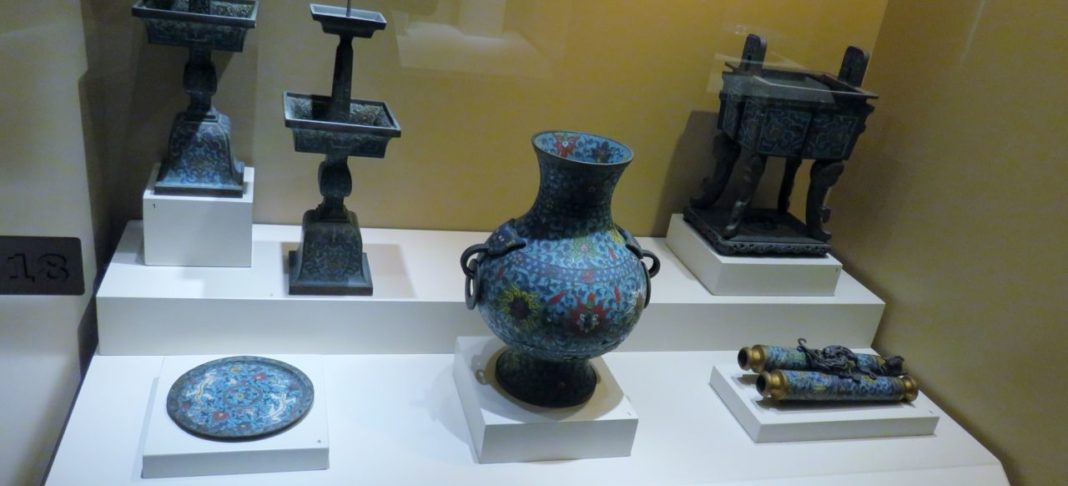By Catherine Tsounis
Understanding and cooperation between Asia and Europe in 2017 is furthered by an unlikely country. Greece has the finest Asian museum in Europe on an Ionian island. The Museum of Asian Art of Corfu is in the Palace of St. Michael and St. George in Corfu, Greece. I understand my Asian neighbors’ culture in New York City, because of a remarkable visit in May 2017.
The main exhibit the summer of 2017 was “Japanese Culture and the Arts of Asia”. I visited the Chinese exhibits, learning about the art of porcelain. Exhibit sign information is never completely on the internet. A person must research books or go in person. I took photographs of signs for later research. Colorful replicas and original porcelain gave the onlooker the impression of porcelain’s “beauty, rarity and luxury. Chinese porcelain became known as White Gold and has developed through a lengthy process of time a variety of products of lustrous body, elegant shape and solid quality. The current exhibition “New Silk Road” is displaying more than forty pieces of porcelain works.”1 I noticed that a benefactor was Charilaos Chiotakis (1915-1998), who following the destruction of Asia Minor, his birthplace, fled as a refugee to Greece. He went in 1929 to Utrecht, Netherlands, where he traded fur. He acquired a large art collection that he donated to the Museum of Asian art. Throughout Greece, I saw that the major benefactors were from Epirus and Western Anatolia.
My interest is in the Byzantine or Eastern Roman empire’s contacts with Asia. During the Tang dynasty (618-907 A.D.) overseas commerce with the cosmopolitan Chinese court and Persian and Byzantine delegations. Heraclius, Byzantine emperor 610-641 AD., coins were found in Chinese tombs. In the early 14th century, the Chinese were taught indirectly by the Byzantines, through artists who worked in the workshops of Armenian and Georgian monasteries, the cloisonné technique of working with inlaid enamel.
The main exhibit “Japanese Culture and the Arts of Asia” showed us “The Dawn of Japanese Art” from 1350 B.C. to 552 A.D. on the second floor. Interactions with Korea and China triggered a renaissance of Japanese Buddhism in religious architecture and sculpture. Tea was imported to Japan from China in the 8th century. Green tea became popular in 12th century. The Samurai (Warrior class) adopted the Tea Ceremony called Chado, that spread to all levels of society. Ceramics 17th – 19th century, art on screens and fans and the Edo or 19th century Tokyo period gave an insight into Japanese life.
The Samurai exhibits by the Michael Marks Charitable Foundation reminded me of Darth Vader from a Star Wars movie. The Japanese swords exhibit was impressive. “The Samurai were the military elite that dominated Japanese politics, economic and social policies. They had the bushido honor code that called for blind obedience to their lord. They first appeared in historical records about the 10th century. The samurai were expert in archery, swordsmanship and horseback riding. They were patrons of Buddhism, poets, calligraphers, collectors of paintings, supporters of No and Kyogen theater and sponsors of the construction of beautiful temples and gardens in Kyoto, imperial capital of Japan.” One must go to a museum to see the concept of loyalty. “Powerful warriors of the Momoyama era (1573-1615) inherited these interests and added to it a love of grandeur and splendor…Their castles became the central symbols of the age.”2
Collections include: China (Neolithic to 19th century): ceramics, bronzes, lacquer, painting, textiles, wood sculptures, items of precious materials, jewelry, etc.; Japan (4th-19th century): ceramics, bronzes, lacquer, painting, prints, textiles, everyday life items, Kabuki theatre masks, musical instruments, wood sculptures, glass and precious materials items, Samurai armor and weaponry, etc. Korea (19th – 20th century): ceramics, paintings, Balluch carpets and textiles;
India (2nd century BC to 19th century AD): stone, wood and bronze religious sculpture, miniature painting; Afghanistan-Pakistan (2 century BC- 5th century AD): Gandhara grey schist Buddhist reliefs;
Nepal – Tibet (17th – 19th century): bronze religious sculpture and painted votive banners
Some Southeast Asian sculptures.3
Corfu’s Museum of Asian Art gives an understanding of Asian culture in a context that can be understood by the average tourist. Greece is supporting cooperation between East and West. Hara Armeni of Charitos Travel agency in Corfu arrange my four-day excursion.







